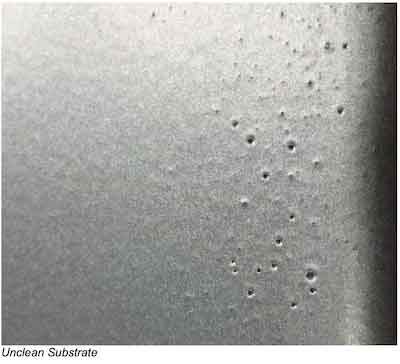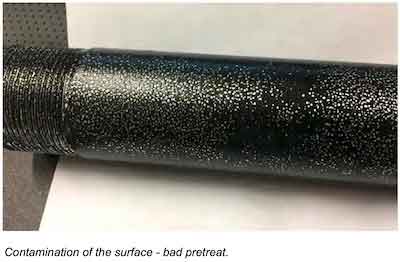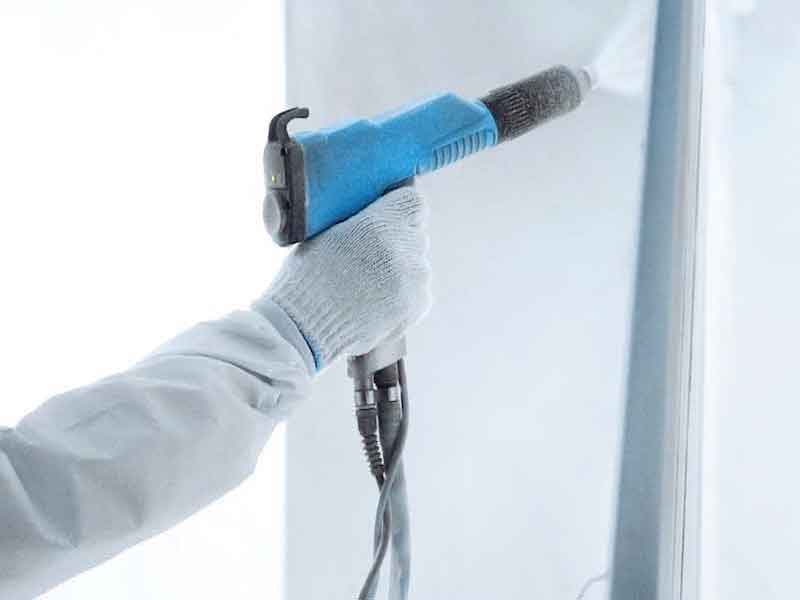So you have your substrate, all prepped and ready and it is time to lay down some coating.
 Fiona Levin SmithThere is a great selection of products available that offer protection and decoration. Some of these products can be used as a two coat system, so let’s dive right in and check two coat systems out.
Fiona Levin SmithThere is a great selection of products available that offer protection and decoration. Some of these products can be used as a two coat system, so let’s dive right in and check two coat systems out.
At the basic level, a two coat system is a method in which two coatings are applied to the same substrate. The most common two coat systems involve laying down a primer, curing it, and then applying and curing a top coat. Sometimes, the first application is a color coat, with the second application being a clear top coat. Pretty simple, right?
Why Should You Use Two Coat Systems?
 Two coat systems can offer some great benefits. Do you want the metal to rust, corrode, or oxidize? Of course not. A two coat system is one way to achieve great corrosion protection, as applying an epoxy or zinc rich powder primer beneath your top coat can do just that. This is an especially great option if you are working with steel, or have limited pretreatment available.
Two coat systems can offer some great benefits. Do you want the metal to rust, corrode, or oxidize? Of course not. A two coat system is one way to achieve great corrosion protection, as applying an epoxy or zinc rich powder primer beneath your top coat can do just that. This is an especially great option if you are working with steel, or have limited pretreatment available.
Two coat systems can also be used if designers want to add a bit of extra flair and pizzazz to a surface, perhaps in the form of a high gloss clear coat. Similarly, they may also want to add some further protection or functionality. For example, certain domestic appliance manufacturers add a fingerprint-free clear powder, on top of their chosen look, to improve the ability to prevent fingerprint marks.
Some powders come with the recommendation of a clear coat for exterior use as well. This is often true of special effects powders and can be a good idea to extend their corrosion resistance and life expectancy. However, it is important to note that for high grade, exterior architectural applications, putting a powder with basic exterior weathering capabilities down and then adding a clear coat designed to pass higher weathering specifications, will not increase the weathering capability of that first coat sufficiently to meet the demanding architectural specs.
Two coat systems can also help enhance colored coatings with bright pigments. For example, at T, IFS Coatings’ sister brand, to achieve the ever popular neon colors, we recommend laying down a white coating (crystal white) first and then applying the Polychem neon color. The combination of the bright white base coat with the neon on top really makes the color pop.
In fact, any sort of coating that has a special effect, like metallics, glow in the dark, and translucent will benefit from a base coat applied beneath them. There is a reason why artists paint on white canvases 90% of the time. A white base enhances the vividness of any color.
There are many more reasons why you might do a two coat system, like a thicker film build requirement to improve the barrier between the elements and the substrate.
There are some great advantages to two coat systems, so read on to discover the how’s and why’s.
The great thing about two coat systems is that they are easy to use – so anyone can perform them. So let’s check out the top tips for application and achieving the very best results.
Two Coat, Two Cure Systems
This method is likely very familiar to most of you. Laying down a primer or base coat, curing it, and then applying your top coat and curing that is a dance as easy as singing your A, B, C’s. This method is also used for a top coat and clears.
This process is easily applied after pretreatment – whatever the type of pretreatment you are using. After pretreatment, simply apply your first coat and cure it in line with Technical Data Sheet (TDS) requirements. It’s good to note that most of the time you will need a full or almost full cure on this first coat. Likewise, don’t overbake it. Overbaking the first coat can really affect inter-coat adhesion. Then simply apply and cure the second coat.
Watch the thickness of the base coat. Too thick, and you will have trouble applying the topcoat. Remember with powder coating, the electric charge will not pass through a thick base layer as easily as it would a thinner one (it always needs good ground).
Two Coat Systems: The Pros and Cons
Applying more product to a substrate may mean adding time and money to a job. Whether or not it is worth it, is up to you. The advantages in increased performance and product longevity are often well worth it though.
Plus, if you apply the first layer on too thick, you will either have an uneven – and likely unattractive – top coat or if you apply a clear top coat on too thick you will find that it turns milky. Not something you want to give to a client.
In the pro column, using a two coat system can be a pretty dang simple way to really enhance the corrosion performance of your coatings – not to mention the added benefits in looks and lifetime.
The Do’s and Do Not’s of Applying a Two Coat System
 Below, we have compiled a list of tips that our tech service team have learned over their many years of applying powder. Like with any coating, experience helps, but some of it can be trial and error, so give it a go.
Below, we have compiled a list of tips that our tech service team have learned over their many years of applying powder. Like with any coating, experience helps, but some of it can be trial and error, so give it a go.
- First up: Good ground is essential for clear coats. If you do not have good ground, you will have problems with starring or back ionization. Starring looks like you have a sand dollar on the surface, and they can be as small as a pencil eraser and as big as a dime. Back ionization gives the coating a rough look – more like a grapefruit peel than orange peel. This might mean cleaning excess or baked on powder from the racks and hooks so you have good metal to metal contact. You should aim for one megohom or less resistance to ground at 500 volts – you can measure whether or not you have good ground by getting an ohmmeter, which measures electrical resistance and you can pick one up for under $50.
- Test any product (by itself or with another) on panels or pieces before coating anything for a client. That way you will truly get a feel for how the products work and can make any necessary adjustments before coating the part.
- In pretreating, make sure the part is properly rinsed and dried. Also, do not let the pretreat simply dry in place. Leaving it to dry on its own means water spots can form. Even when you paint over these spots, you will see little dry spots underneath the coating and worst case scenario, these spots can even blister.
- Many powder products may work as a two coat process but have not been designed as such. Conversely, many simply won’t work together. Unfortunately, learning what does and does not work together often comes down to trial and error. Staying within the same brand of powder for both coats at least allows you some consistency and enables you to check with the manufacturer for recommendations if problems occur.
- Do not overbake in between coats. Doing so can cause inter- coat adhesion problems.
- Remember, with two coat systems the thicker film build also reduces the ability of the top coat powder to take a charge. Good film thickness is key.
- Similarly, it is tempting to do so, but do not lay on a clear topcoat thickly. It’s easy to do as clear coats often apply well, but the thicker you apply a clear coat, the less clear it becomes, often taking a milky coloration. You may not even realize you’re doing it, so be careful. Investing in a film thickness gauge will enable you to quickly check and measure the exact thickness of a coating once it has been cured; you can pick up a decent gauge for a few hundred bucks.
- Check the cure requirement of both coats. Are both low cure formulations or is one a regular cure and the other a low cure? You need to take this into consideration and adjust your cure schedule accordingly. For example, if you’re using a regular cure primer, make sure it’s fully cured or almost fully cured before you apply a low cure top coat. If you don’t, the primer won’t perform as it’s designed to as it never fully cured.
- Another common sense tip here, but do not let the product get contaminated – both in its container or while it is on the substrate, especially between coats. Dust, dirt and even the oil from your hands can cause trouble down the line – from starring to leaving a fingerprint on the paint - and then you end up sealing it in with a clear topcoat. So, don’t leave too long between applying coats and do not handle the substrate between applications or cures. Keep your products sealed in their containers when not in immediate use.
 A lot of these tips that we have covered come will a fair bit of trial by error, not all ovens work the same and nor do all metal substrates accept the product in the same way. The great thing about powder coating is anyone can do it and the more you do it, the better you become. The more experienced you are, the more likely it is that most of this will be second nature to you.
A lot of these tips that we have covered come will a fair bit of trial by error, not all ovens work the same and nor do all metal substrates accept the product in the same way. The great thing about powder coating is anyone can do it and the more you do it, the better you become. The more experienced you are, the more likely it is that most of this will be second nature to you.
Dry On Dry
The Dry on Dry, or CoCure process, has picked up in popularity over the last few years. A CoCure or dry on dry process involves pretreating the part as usual and then applying your first coat. Then, without curing the first coat, apply your second coat. The final step sees both coats cured together.
Pros and Cons
It certainly has its advantages, including reducing the need to move parts in and out of the oven which of course comes with the risk of contamination, and less time and energy spent in the application and curing process. Cycling through the application, curing, cooling, testing process adds time and money to any job. A dry on dry two coat system can save you both, by, essentially, cutting out the middleman.
The not-so-great aspects of this two coat method are that you can’t just slap any two primers and topcoats together and have it work. You may get lucky, but the only way to achieve guaranteed results is to use products that are formulated to work together in a dry on dry process. Otherwise? You may get a peeling, cracked mess of a coat. Not a good end game.
Adjust the KV settings on the guns between coats. Lowering the KVs when applying the primer and then readjusting the settings higher again for the top coat can help reduce the chance of back ionization or KV rejection. Play with it and see what works best on your system.
What’s more, applying your first coat of powder while the part is still warm from the dry-off oven can help attract the powder and actually cause it to gel slightly, starting the cure and quickening the process. This is especially true if you’re working with thick or heavy parts.
Conclusion
A two coat system is a great way to enhance and protect your substrate, either from the weather or from sticky fingers. Some powder coatings are designed as two coat systems, others simply happen to work together. So often, deciding to use a two coat system will depend on what you are coating and what you need the product to achieve. Using steel and looking for improved weathering? That zinc rich primer and top coat designed for exterior applications are a no brainer. Looking to achieve that bright neon glow or extreme chrome effect? Get that bright base coat down first. There are many great two coat products available.
For further questions or inquiries drop us a line at coatingsinfo@ifscoatings.com
Fiona Levin-Smith is Vice president of Marketing and Specification for IFS Coatings. For further questions or inquiries, visit www.ifscoatings.com



































